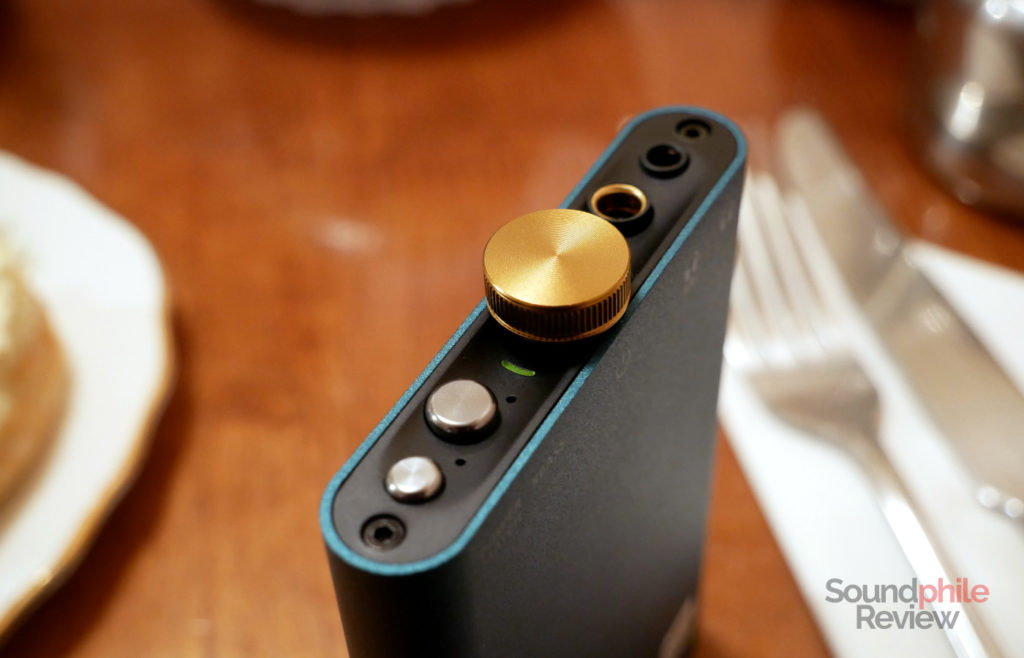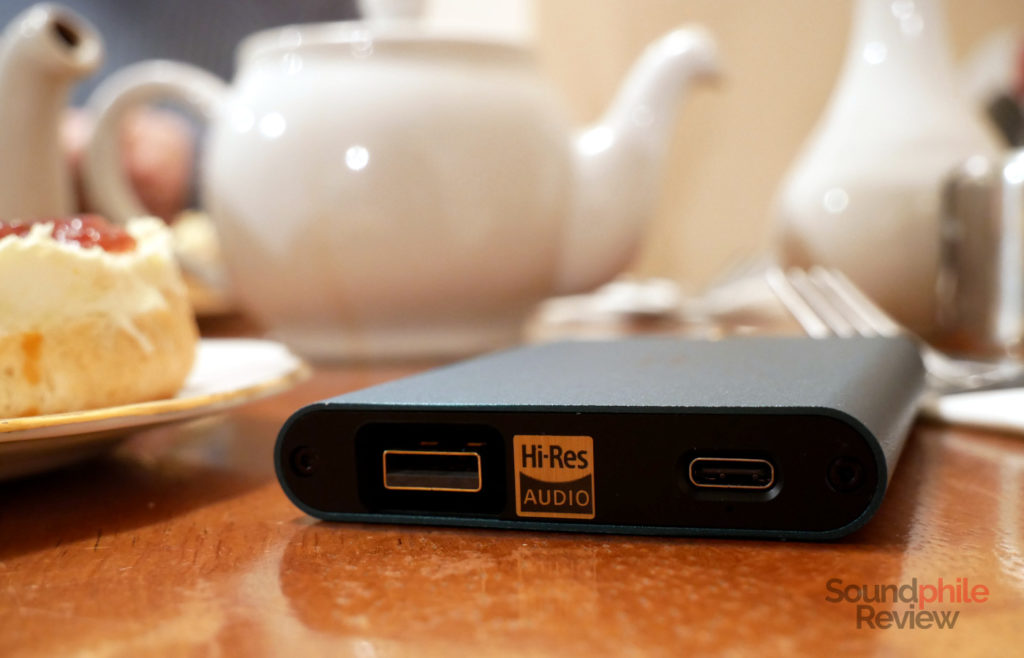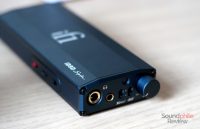iFi has been shrinking the size of their products lately, but with this loss in size and weight does not come a loss in functionality or power – on the contrary, the company has been consistently adding new features to its new products. The new iFi hip dac appears to be the first in a new line-up and somehow outputs 400 mW.
Disclaimer: this unit was loaned to me by iFi directly. It sells for $149.
TL;DR: recap
| Pros |
Cons |
| Well designed and built
Small and portable Good battery life Very powerful Affordable |
Not really…? |
Rating: 9.5/10
Accessories & Packaging
We’ve already seen the iFi hip dac being unboxed, so I recommend you to read that article to find out more (and to see a few pictures, too). In short, the box holds the hip dac, a USB to USB-C cable, a USB to female USB cable and a USB-C to female USB cable (basically a USB OTG cable for USB-C devices).
Design & Build

The iFi hip dac reminds me of a hip flask… which I actually did not know it was called like that in English, so the DAC’s name actually makes total sense! The styling is definitely retro, with the cerulean body (or petrol blue, as iFi says: colour names are hard) being topped by the bronze/copper volume knob. The most notable thing is however the colour in and of itself – you don’t see much blue stuff in the audiophile world, where most products are black or silver.

The body is built out of aluminium, a single block of metal with plastic at both ends. This makes it quite resistant and durable – it should be a long-lasting device as far as build is concerned. The aluminium is not perfectly smooth and has a grainy texture which actually helps with grip.

The upper end hosts the volume knob, the status LEDs (one at each side of the knob), the outputs (3.5 mm and 4.4 mm jacks), the gain button and the XBass button. The other end is home to a male USB-A connector and to a USB-C connector with a LED which indicates whether the device is charging or not. The LEDs around the volume knob show which kind of stream is being reproduced: there are various colours that tell you whether the stream is PCM (44/48 kHz is green, ye

The volume knob also acts as the power switch and then spins freely, with a smooth motion that requires a bit of force to activate. This is especially important as it means it won’t spin while you keep the hip dac in your pocket, and it also allows for better precision in adjusting the volume. There is a silent zone when one begins to spin it, but it’s really small. The knob is also analogue, which should be theoretically better than a digital one.
Features & Specs

As the name says, the iFi hip dac is purely a DAC: it needs a digital source, more specifically a USB source, in order to work. One can therefore not take advantage of the amplifier alone and must use it with the DAC stage, too. On with the nerdy part, specs!
iFi hip dac |
| Input | USB (up to 384 kHz PCM, no bit depth specified, MQA and DSD256) |
| Suitable headphones impedance | N/A |
| Output impedance | N/A |
| Maximum output power | 400 mW (16 Ω) |
| Frequency response | N/A |
| THD+N (@1 kHz) | N/A |
| SNR | N/A |
| Crosstalk | N/A |
iFi does not really publish much technical information on the hip dac – they just tell us the maximum output power is 400 mW at 16 Ω but they don’t even specify whether this applies to balanced, unbalanced or both.

iFi keeps on using Burr-Brown DAC True Native chips just like in previous products, as they believe them to still be the best on the market. They pair them with their own amplification stage developed in-house. Power output is more than enough to drive my HiFiMAN HE-560 with ample room to spare. In fact I don’t even have to use the larger gain in order to get to a comfortably high volume. On the other hand I found power output to actually be excessive for more sensitive earphones. So while you generally don’t need an attenuator with the hip dac, sub-32 Ω earphones will probably benefit from it unless you want to damage your hearing.
The iFi hip dac actually uses two DAC chips, one per channel, which is why it offers balanced output through the 4.4 mm jack just one DAC chip, despite offering a balanced output. The main advantage of a balanced signal path is that it offers less noise. The hip dac offers simlar advantages even when using the standard 3.5 mm output as it uses what iFi calls the S-Balanced tecnology: the DAC works as if it were outputting the signal to a balanced connection, but then this signal is instead transformed into single-ended. This should theoretically be a “best of both worlds” approach – less noise but no special connector.
Battery Life

Using a mixed array of headphones to test the iFi hip dac I got about 10 hours of playback on a single charge, which is quite good considering the size of the device. This is quite good actually, though I was not able to get the 12 hours advertised by iFi.
As the volume knob acts as a power switch, the hip dac does not automatically turn off – so if you forget it on like I did multiple times, you will run out of battery faster than you’d like.
One thing I also like is the fact that the full-size USB port does not drain battery from the source device: in order to charge the hip dac you have to use the USB-C port, so you can use the hip dac with portable devices (laptops, tablets, phones) without draining their battery. iFi notes that the hip dac will keep on draining the battery if you connect the USB-C cable when the device was already on.
Sound
I tested the iFi hip dac using various headphones and earphones, including the Spirit Torino Radiante, the HiFiMAN HE-560, the Shozy Form 1.4 and the NiceHCK NX7 Pro.
There is a tiny bit of hiss in the background, but it’s so faint it is only noticeable when there is perfect silence and no music is playing. Plus, I have only been able to hear it using highly sensitive IEMs.
As far as I am able to discern, the iFi hip dac offers no colouration of the sound it produces. In fact it offers a neutral signature which makes it undistinguishable from other gear I’ve tried (e.g. Burson Audio Playmate, Shanling UP4). In fact it’s even really good as far as speed is concerned, with a fast transient response. I can’t really hear anything that strays from neutrality and a reproduction of music “as it is”. If there is any difference, then I can’t hear it (and I probably would not be able to measure it, either).
Contrary to previous devices by iFi, the hip dac does not offer their famous 3D+ technology. The XBass tech stayed, though, and it increases presence of lower frequencies. In particular, it gives the largest boost to sub-bass with a decreasing emphasis as frequency goes up. It is very well implemented as it does not make bass overwhelming and instead it only gives it more presence (though of course that also depends on the signature of the headphones, as bassy headphones will probably end up having too much bass).
iFi hip dac Comparisons
Here’s a brief comparison with other similar devices:
- iFi hip dac vs Topping NX4 DSD: the NX4 DSD and the hip dac share many similarities, starting with the size: the Topping DAC/amp is slightly larger than iFi’s, but they’re really close. Both feature separated ports for charge and data, bass boost technologies and a gain selector. The NX4 DSD offers a dedicated line output which can also act as input, so the device can be used as a pure amplifier; the hip dac has no such feature, but it offers balanced output through a 4.4 mm jack. In terms of sound there are minor differences, if any: the hip dac is warmer, while the NX4 DSD offers faster and more impactful transients. All other things are equal, though. The other main difference is power output: the hip dac offers 400 mW, while the NX4 DSD reaches 293 mW; this allows the iFi DAC/amp to power a larger variety of headphones.
- iFi hip dac vs iFi nano iDSD Black Label: the nano iDSD BL is a bit like the grandfather to the hip dac. It’s definitely bulkier and less powerful, while also offering a few additional features as it offers IEMatch, filters and dedicated line out; on the other hand it does not have the XBass tech on board nor a balanced output. In terms of sound signature they’re really close, though the nano iDSD BL does have more background hiss.
- iFi hip dac vs RHA Dacamp L1: the Dacamp L1 costs more and offers some additional features, but also offers less overall power output (300 mW vs 400 mW). The sound is quite similar and I can’t hear specific differences between the two units. Both offer balanced output, though the Dacamp L1 offers a very rarely seen mini-XLR4. In terms of inputs, though, the RHA offers more flexibility thanks to its optical and 3.5 mm jack inputs. It also offers more flexibility in terms of gain and equalisation thanks to its dedicated knobs. The hip dac is more basic in its features, but it also costs half the Dacamp L1 – and it’s also much more portable.
Final Thoughts
Please, iFi, stop making wonderful products, I’m tired of giving you very high marks! On a more serious note, the iFi hip dac offers extremely high value. It’s almost an audio miracle as it is so small and yet it packs such a large output power with a few additional features on top of it. It’s small, portable, powerful, well-built. And it’s amazing how iFi managed to offer it for just $149. What else could one want?









Hey there!
1- Maximum power output of 700mW on balanced, depending on headphone impedance (that’s what most say)
Though ifi-audio.com hip dac specs list maximum 400mW@32 ohm on balanced, 280mW@32 ohm on s-balanced SE.
I do not understand how mW power output increases or decreases with different headphone impedances. Am I right that higher impedance headphones require more power (voltage), they are less sensitive, and thus will have less mW power output? Very confusing indeed. I hope you can share some insights into this.
2- My first encounter that the hip dac has two DAC chips. My understanding is DACs with balanced outs having separate left and right channels doesn’t mean two chipsets.
ifi-audio.com says the hip dac’s “Burr-Brown True Native chipset means…” They specifically referred to a singular CHIPSET, not chipsets.
I got my hip dac March 2, ordered it February 22 I think, and am enjoying it. I also have the nicehck nx7 pro.
Stay safe!
-jojo
PS: I have to do this a second time. The first one disappeared before I was to click on the submit button. Sorry if you receive two of these.
Hi Jojo,
Your message totally flew under the radar – sorry! So yeah, as impedance increases you have less power (mW). Think of it this way: your amplifier is a tap to which you have attached a hose (your headphones). You have to reach a certain pressure because you need to water some plants you can’t reach otherwise. Impedance is like the width of the hose: the larger it is, the lower is the pressure and the more water you have to get from the tap. Bear in mind I don’t think this example is 100% accurate, I just wanted to get a visual representation to get the point across.
So this stuff is not about sensitivity, it’s about impedance which is (in layman’s terms) how difficult it is to get the current to flow in a certain circuit. The harder it is for current to flow, the higher the impedance is and the less power you can input.
As for the DAC: damn, it seems you’re right! I will check in with iFi on this, but it seems like this is not a “true” balanced implementation as the DAC only offers two channels. Theoretically only a system with two DACs, or with DACs able to process four channels, is to be considered balanced. Thanks for pointing that out!
Thank you for the very informative review. You mentioned that it was undistinguishable from recent gear you had tried, giving the Burson Audio Playmate as an example. Does that mean in a blind test you would not be able to tell them apart? Also, would you say that the hip-dac would have enough power to drive hd650s to their full potential?
Many thanks in advance,
Hello! I’m glad you found my review useful. I do not have the equipment for a proper blind test, so what I did was just to compare the hip dac with the other devices side by side. What I did was to reproduce the same part of a track over and over, switching from one device to the other, relying on my echoic memory to assess the differences. Although this is admittedly far from perfect as methodology, I read a paper a couple of years ago about how echoic memory is able to find differences with a precision of up to 0.1 dB (I will update this comment if I find it again). On top of this, the measurements of practically all solid-state DACs and amplifiers tell the same story – that they sound the same.
As for the HD 650, you should have no problem at all.